History
Mississauga Nation to early townships
During the period of European settlement, commencing in 1781, the British government purchased blocks of land from the Mississauga Nation. By 1818, additional land purchases led to the development of the Esquesing and Nassagaweya townships.
Timothy Street and Abraham Nelles were contracted to lay out the townships. Charles Kennedy was hired by Nelles to survey the northern tract. Kennedy received a significant parcel of land as payment for his work. Kennedy's brothers (John, Morris, Samuel and George) subsequently acquired adjacent tracts in the Silver Creek Valley.
Sawmills and Wilbur Lake
George Kennedy arrived in the area in 1823. He calculated that a small water supply along the Silver Creek would be sufficient to power a sawmill. The sawmill, and lake, that he built became the centre of a small settlement. The sawmill location was near the current intersection of Main Street and Wildwood Road.
In 1828, John Galt, through the Canada Company, opened a road which connected the settlement around George Kennedy's Mill with other settlements in the area. As Kennedy's Mill prospered, he built a gristmill, foundry and a woolen mill. Unfortunately, after that initial period of prosperity, business was poor. This led to the area being nicknamed 'Hungry Hollow'. In 1834, the Barber brothers arrived in Hungry Hollow, and within three years had purchased the mills from Kennedy.
In 1837, when James and William Barber purchased the mills and land from George Kennedy, the area adopted the name Georgetown, in honor of the original mill owner. The pond along Silver Creek, that provided water power for operating the mills, was named Wilber Lake, deriving its name from Williams (Glen Williams) and Barber (the enterprising Irish brothers). The lake was located near the present site of St. George's Anglican Church.
The lake provided water power for the mills, and recreation for the growing community. Villagers would, depending on the season, go fishing, canoeing or play hockey on the lake. There were, however, periods when the lake dried up. This earned it the local nickname of 'Lake Sometime', because sometimes it was there and sometimes it wasn't!
Nonetheless, both Wilbur Lake and Silver Creek played an important part in the area's ecosystem. Charles Young, son of Georgetown pioneer James Young, in his reminiscence of old Georgetown relates that,
"before dams were built to impede their passage, sea salmon swarmed up the Credit and all streams falling into Lake Ontario,
and that in the spawning season they were packed so thick in the Credit that if they had not moved one could walk in their backs dry-shod".
Decline
There were many other bodies of water that once connected to the Wilber Lake (later Wilbur Lake). The advent of hydro-electric power altered many of these sources.
In 1915, Wilbur Lake disappeared during the construction of a wooden trestle for the Toronto Suburban Railway. This vanished pond, which once graced Georgetown, and helped generate power for the earliest industries, was gone.
Silver Creek, a tributary of the Credit River is the only source of water that is still from (what once was) Wilbur Lake. Silver Creek, itself, is greatly diminished in size and flow from the period of sawmills and industrialization.

Potter is a town in Yates County, New York, United States. The Town of Potter is located in the northwest part of the county and is south of Canandaigua. The population was 1,865 at the 2010 census.

Georgetown is a large unincorporated community in the town of Halton Hills, Ontario, Canada, in the Regional Municipality of Halton. The town includes several small villages or settlements such as Norval, Limehouse, Stewarttown and Glen Williams near Georgetown and another large population centre, Acton. In 2016, the population of Georgetown was 42,123. It sits on the banks of the Credit River, approximately 40 km west of Toronto, and is part of the Greater Toronto Area. Georgetown was named after entrepreneur George Kennedy who settled in the area in 1821 and built several mills and other businesses.

Athens is a township in the United Counties of Leeds and Grenville in Eastern Ontario, Canada. It is located approximately 25 kilometres (16 mi) north of the St. Lawrence River, near Brockville, west of Addison, and about 90 kilometres (56 mi) south west of Ottawa. Formerly, it was a part of Yonge township before becoming Rear of Yonge and Escott with Athens as its own census division and finally, Athens township. The township consists of the town of Athens and a few other small communities.

Erin is a town in Wellington County, approximately 80 kilometres (50 mi) northwest of Toronto, Ontario, Canada. Erin is bordered by the Town of Caledon, Ontario to the east, the Town of Halton Hills to the south, the Township of Guelph/Eramosa to the west and the Township of East Garafraxa to the north.

Puslinch is a township in south-central Ontario, Canada, in Wellington County, surrounding the south end of Guelph. The main source of production is agricultural, spring water bottling and mining. Aggregate mining has been dominant throughout the county. About half of the township is forested, and a conservation area lies to the southwest. Near the western edge of the township, just outside Cambridge, Ontario, is Puslinch Lake, the largest kettle lake in North America. It is part of the Guelph census metropolitan area.

Acton is a community located in the town of Halton Hills, in Halton Region, Ontario, Canada. At the northern end of the Region, it is on the outer edge of the Greater Toronto Area and is one of two of the primary population centres of the Town; the other is Georgetown. From 1842 until 1986, the town was a major centre for the tanning and leather goods industry. In the early years, it was often referred to as "Leathertown".

Waterdown is a community in Canada which since 2001 has been a community of Hamilton, Ontario. Waterdown is approximately 60 km west of downtown Toronto.
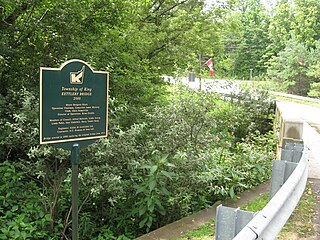
Kettleby is an unincorporated community in the northeastern part of King Township in Ontario, Canada. It is located about 1.5 kilometres (0.93 mi) east of Highway 400, 25 kilometres (16 mi) north of Toronto, about 40 kilometres (25 mi) south of Barrie, 6 kilometres (3.7 mi) west of Newmarket, and about 50 kilometres (31 mi) east of Orangeville.
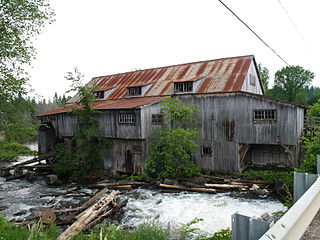
Balaclava is a dispersed rural community in the township municipality of Bonnechere Valley, Renfrew County, in Eastern Ontario, Canada. It is on the former Ontario Highway 513 just off Ontario Highway 132 north of the community of Dacre, and at the outlet of Constant Creek, a tributary of the Madawaska River, from Constant Lake, approximately 30 minutes drive time from the town of Renfrew.
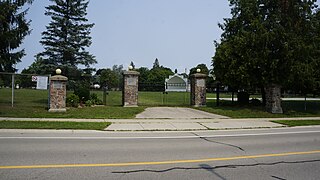
New Dundee is a small community of 1,119 people at the time of the 2016 Census, in the township of Wilmot, Ontario, Canada. It is located southwest of Kitchener.

Larrys Creek is a 22.9-mile-long (36.9 km) tributary of the West Branch Susquehanna River in Lycoming County in the U.S. state of Pennsylvania. A part of the Chesapeake Bay drainage basin, its watershed drains 89.1 square miles (231 km2) in six townships and a borough. The creek flows south from the dissected Allegheny Plateau to the Ridge-and-valley Appalachians through sandstone, limestone, and shale from the Devonian, Mississippian, and Pennsylvanian periods.

Delta, Ontario, is a community in the Township of Rideau Lakes, Leeds and Grenville County in Eastern Ontario. The village is located between two lakes, Upper Beverley and Lower Beverley, along highway 42, approximately 15 kilometres west of Athens, Ontario and 28 kilometres east of Westport, Ontario.
Indiana is a ghost town in Haldimand County, Ontario, Canada. It was located on the north-east bank of the Grand River, north of Cayuga. The town flourished in the mid- to late 19th century as a mill town and base for the river transport trade. Until the 1860s it was the largest industrial town in Haldimand County, but by 1905 it was largely abandoned. Part of the 1,200-acre (490-hectare) townsite is now included in the Ruthven Park National Historic Site of Canada.

Ear Falls is a township located in Northwestern Ontario, Canada, on the banks of the English River, Lac Seul, Pakwash Lake and Wenesaga Lake. It is located along Highway 105, 100 kilometres (62 mi) north of Highway 17 and Vermilion Bay, about halfway between Highway 17 and Red Lake, or about 480 kilometres (300 mi) northwest of Thunder Bay.
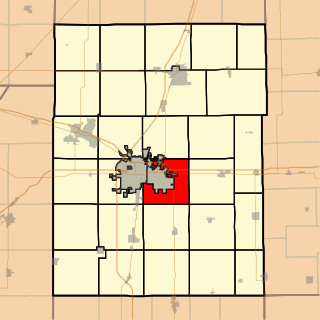
Urbana Township is a township in Champaign County, Illinois, USA. As of the 2010 census, its population was 7,451 and it contained 3,435 housing units.
George Kennedy (1799-1870) was a Canadian businessman. Georgetown, Ontario is named in his honour.

Charlton and Dack is a municipality in the Canadian province of Ontario, located within the Timiskaming District. Its population in 2016 was 686.

Floradale is an unincorporated rural community in Southwestern Ontario, Canada. It is part of the township of Woolwich in the Regional Municipality of Waterloo. The community is located 5 kilometres to the north of the town of Elmira, Ontario and 20 kilometres to the north of the city of Waterloo, Ontario. The Canagagigue Creek, a tributary of the Grand River, flows through the village. The community is located in an area where there is an historically large settlement of Old Order Mennonites noted for their traditional customs, dress, and use of horse and buggies.
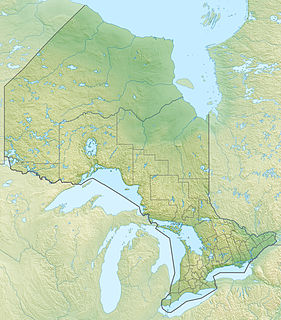
Twelve Mile Creek is a waterway located on the Niagara Peninsula in the Regional Municipality of Niagara in Southern Ontario, Canada. Its headwaters are located in the town of Pelham, encompassing some of the most unspoiled and natural areas of Niagara area. The creek's lower reaches flow through urban areas of Thorold and St. Catharines, and have been heavily altered by human activity for almost two centuries. The creek was first known as "Ashquasing" by the Mississaugas Indigenous people, the name meaning "that which lies at the end" in the Anishinaabe language.
Esquesing Township was a municipality within the historic Halton County in Ontario, Canada. It is today a geographic township in the town of Halton Hills in the Regional Municipality of Halton.
















